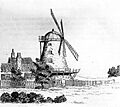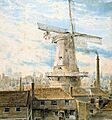List of windmills in London facts for kids
Did you know that Greater London used to have many windmills? These tall, spinning buildings were once very important. They helped people grind grain into flour or pump water. Today, most of these old windmills are gone. But some still stand as reminders of the past.
This article lists windmills that were once in the area we now call Greater London. Back when they were built, this land was part of different counties. These included Kent, Surrey, Middlesex, Hertfordshire, or Essex. Out of all the windmills known to have existed, nine are still here and are protected. The tide mills in West Ham are also preserved.
Contents
What are Windmills and How Do They Work?
Windmills are machines that use the power of the wind. They have large blades or sails that catch the wind. This makes them spin. The spinning motion then powers machinery inside the mill. This machinery can grind grain, saw wood, or pump water.
Types of Windmills You Might See
There are a few main types of windmills. Each type has a different design.
Post Mills: The Oldest Type
A post mill is one of the oldest kinds. The entire body of the mill, which holds all the machinery, sits on a large central post. This means the whole building can turn to face the wind.
Smock Mills: Like a Smock Dress
A smock mill looks a bit like a farmer's smock dress. It has a wide base that gets narrower towards the top. Only the cap (the top part) of a smock mill turns to face the wind. This makes them more stable than post mills.
Tower Mills: Strong and Tall
A tower mill is a strong, tall building, usually made of brick or stone. Like a smock mill, only its cap turns to catch the wind. These mills are very sturdy and can be quite large.
Horizontal and Other Mills
Some windmills are less common. A horizontal windmill has blades that spin around a vertical pole. This is different from the more common windmills where blades spin around a horizontal pole. There were also vertical axle mills and hollow post mills.
Famous Windmills in London Today
Several windmills have been saved and restored. You can visit some of them!
- Barnet Gate Mill in Arkley is a tower mill. It was built around 1830.
- Ashby's Mill in Brixton is another tower mill. It was built in 1816.
- Keston Mill in Keston is a post mill. It dates back to 1716.
- Plumstead Common Mill is a tower mill built in 1820.
- Shirley Mill in Shirley is a tower mill. It was built in 1855 after an earlier post mill burnt down.
- Abraham's Mill in Upminster is a smock mill from 1803.
- Wandsworth Common Mill is a smock mill built in 1837.
- Wimbledon Common Mill was built in 1816. It started as a hollow post mill and was rebuilt as a smock mill in 1893.
A Look Back: Windmills Across London Boroughs
Many areas in London once had windmills. Here are some examples from different parts of the city.
Windmills in North and West London
- In Acton, there were several windmills. One was a smock mill, active from 1801 to 1859.
- Edmonton had a post mill at Weir Hall. It was used from 1627 to 1801. Another post mill, Silver Street Mill, was active until 1920.
- Enfield had a smock mill built in 1790. It was taken down in 1904.
- Hampstead had a post mill called Coneyfield from 1597 to 1661.
- In Hounslow, the Heston Mill was a post mill built in 1818. It unfortunately burnt down in 1895.
- Islington had two tower mills called White Lead Mills. They were built in 1786 and 1792.
- Kensington had a post mill in Hyde Park from 1543 to 1660.
- Willesden had a smock mill in Kilburn. It was built in 1803 and burnt down in 1863.
Windmills in East London
- Barking had a post mill in 1243. Later, the Wellington Mill, a smock mill, was built in 1815 and demolished in 1926.
- Bow had both a post mill and a smock mill around 1823-1852.
- Dagenham had several windmills. The Becontree Heath Mill, a smock mill built in 1816, burnt down in 1869.
- Limehouse had a smock mill built in 1768, which was destroyed in a riot.
- Poplar (especially Millwall) was home to many post mills and a smock mill in the 1700s.
- Romford had several post mills, including the Rising Sun Mill, which was active until 1871.
- Stepney had windmills as early as 1325.
- West Ham had many windmills, including the Three Mills, which were tide mills. Some windmills here were moved to other locations.
Windmills in South London
- Battersea had various mills, including a smock mill called Red House Mill (1753-1851) and a unique horizontal mill called Fowler's Mill (1788-1825).
- Bermondsey had several post mills. Poupart's Mill burnt down in 1866.
- Brixton had the Brixton Hill Mill, a smock mill, from 1803 to 1845.
- Bromley had a post mill from 1665, demolished in 1835.
- Camberwell had a post mill called Camberwell Mill (1709-1831).
- Croydon had several mills, including the Black Mill (a post mill from 1814) and the White Mill (a smock mill from 1828).
- Deptford had a smock mill (1843-1854) and a post mill (1840-1849).
- Dulwich had a post mill on Dulwich Common in 1814.
- Greenwich had both post and smock mills.
- Lambeth had various mills, including a smock mill called Cons Street Mill (1800-1840).
- Southwark had post mills in St George's Fields from the early 1600s.
- Streatham had Streatham Mill from 1816 to 1823.
Images for kids
Maps That Show Old Windmills
Old maps are a great way to see where windmills used to stand. Here are some of the maps that show windmills in London:
- c.1563 "Woodcut" (or "Agas") map of London
- 1610 John Speed map
- 1647 Wenceslas Hollar (Long View of London from Bankside)
- 1658 William Faithorne map
- 1673 Richard Blome map
- 1675 John Ogilby map
- 1724 Sutton Nicholl (View of London and Southwark)
- 1746 John Rocque map
- 1762 John Rocque map
- 1769 Andrews, Dury and Herbert map
- 1816 Ordnance Survey map
- 1823 Bryant map
- 1824 Christopher Greenwood (Map of London)





















